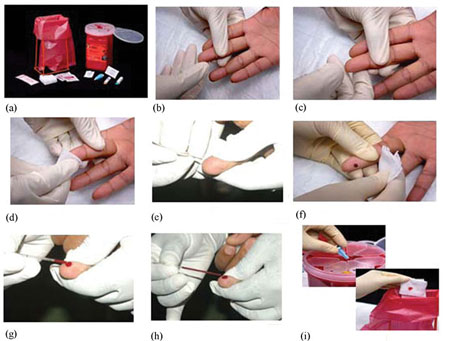Step 3:Obtaining a specimen for HIV testing
Specimens used for HIV testing include serum, whole blood, or oral fluids. In Ethiopia, whole blood is used for rapid HIV testing. The blood specimen is obtained by a finger prick (as outlined below and illustrated in Figure 24.2).
1 Prepare a container for disposing of sharp instruments; also prepare gloves, lancet, alcohol swab, cotton swab, pipette, capillary tube, the test kits, and other necessary materials (Figure 24.2a).
2 Wash your hands with an antiseptic soap and water.
3 Wear clean gloves.
4 Position the hand of the person to be tested palm-side up. Select the softest finger; avoid those fingers that have calluses or hardened skin (Figure 24.2b).
5 Massage the chosen finger to help the blood to flow (Figure 24.2c).

6 Clean the fingertip with an alcohol swab (Figure 24.2d). Start in the middle of the finger and work outwards; this will prevent contamination of the cleansed region. Allow the finger to dry.
7 Hold the finger and firmly place a new sterile lancet off-centre on the fingertip. Firmly press the lancet to puncture the fingertip. (Figure 24.2e).
8 Wipe away the first drop of blood with a sterile gauze pad or cotton ball. Apply intermittent pressure in the base of the punctured finger several times (Figure 24.2f).
9 Blood may flow best if the finger is held lower than the elbow. Touch the tip of the capillary tube to the drop of blood (Figure 24.2g).
10 Ensure you fill the capillary tube with blood between the two marked lines. Avoid getting air bubbles trapped in the capillary tube (Figure 24.2h).
11 Properly dispose of all contaminated supplies (Figure 24.2i).